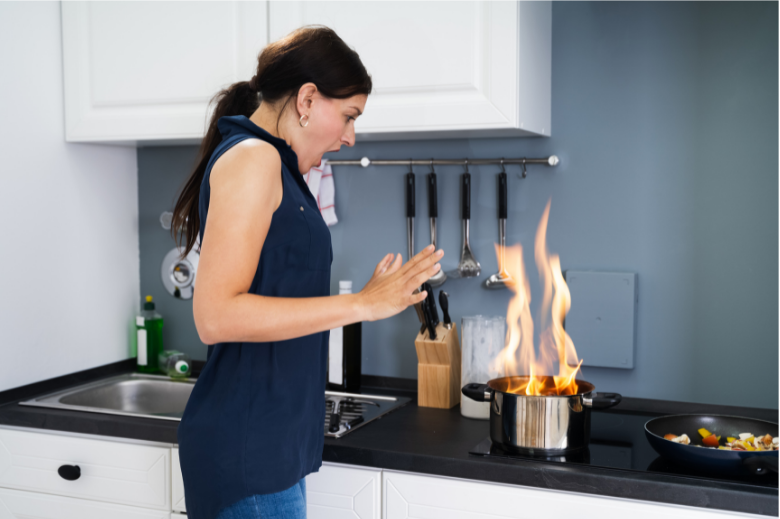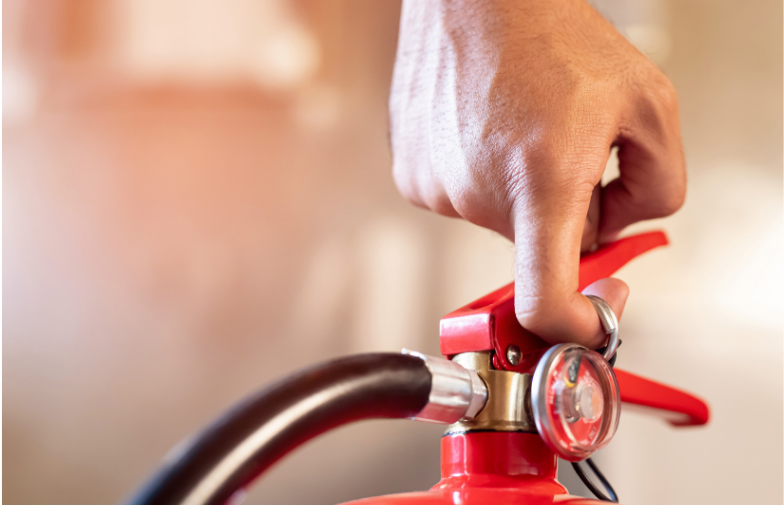
More fires start in the kitchen than in any other place in the home. Aside from being common, cooking fires can also be deadly. Kitchen fires caused by cooking equipment make up on average 49% of home fires, 21% of home fire deaths and 44% of home fire injuries, according to a 2014-2018 study by the National Fire Prevention Association (NFPA).
Here are few ways that kitchen fires can start and some firefighting prevention tips. Also make sure you have home exit strategies in place – and know when to give up. Sometimes getting out and to safety is the best plan of all.
Causes of kitchen fires
Some of causes of kitchen fires are:
- Unattended or distracted cooking. Unattended equipment was involved in 31% of cooking fires, according to the NFPA. Fires and injuries can happen even after the cooking process is over. It’s surprising how often a burner is left on after cooking, forgotten in the rush to finish the job.
- Grease or messes. Grime buildup in burners, on the stovetop or in the range hood is a cause for concern. Frequent cleaning will prevent this buildup and a fire from igniting or spreading. Cooking grease (from deep frying, sautéing or greasy foods like bacon) also cause fires and will spread quickly if not extinguished properly. Never throw water on a grease fire – use baking soda, salt or a kitchen-appropriate fire extinguisher (more on this below).
- Clutter or poor organization. Never leave handles facing outward where children, pets or other people can knock the cookware off the stove. Cooking on a range top necessitates constant attention to prevent fires and injuries. Flammable items left too close to open burners or electrical heating devices can cause fires, too. Always leave flammables such as dish towels, oven mitts, plastics, packaging and aerosol cans (such as nonstick spray) away from open flame or radiant cooktop surfaces.
- Clothing. Do not wear highly flammable fabrics or dangling fabrics (such as scarves or flowing sleeves) when cooking. They can catch fire easily and cause flames to spread or fabric to melt into your skin. Tie back your hair while cooking so it doesn’t fall into open flame areas.
- Moving or spilling hot foods. The path from the range or stove to the sink, table, or countertop should be checked for obstacles before the hot food is moved.
- Lack of planning or panic. Once a fire starts, it can spread within seconds. The opportunity to spread a fire is even higher in a kitchen when there are no proper fire extinguishing methods nearby or a plan in place. Keep a pot lid, metal sheet pan, box of baking soda or container of salt within easy reach. Do not use kitchen towels, clothing or aprons to try to beat out a fire. Fabrics are flammable (some more than others) and spread the flames even farther.
Fires can be prevented with caution and a plan. Take some time to assess your kitchen and make sure that you’ve eliminated hazards. Make a plan and rehearse the plan with your household.
Make a plan
Fire extinguishers
Make sure to have an ABC-rated fire extinguisher in your kitchen. These fire extinguishers are formulated for general use and can cover many normal home fire situations. These ratings generally stand for:
- A – Woods, trash, paper, plastic, textiles, fabrics
- B – Liquids, grease, oil, gas, kerosene, paints
- C – Electrical
The class K fire extinguisher is also rated for kitchen use and is normally recommended for commercial-grade kitchens.
- K – Combustible cooking materials (grease and fats)
- Class K might be appropriate based on your kitchen appliances and activities (like deep fat fryers or griddles).
- Unlike ABC-rated fire extinguishers, class K is formulated specifically for kitchen use and should not be used on fires outside of the kitchen.
Read the instructions, understand how to use your fire extinguisher and practice using it. The ratings of fire extinguishers matter because different chemical formulas are rated for different types of fires. You would not fight a chemical fire, for example, with a home extinguisher designed for things like woods, drywall or fabrics.
Exit paths and strategies in the event of a kitchen fire
Look around your kitchen and determine which exits are available in case a fire breaks and you need to leave your house. Try to plan for at least two ways out. (If one exit is blocked by fire or smoke, for example, is there a window you can open or break to escape?) Rehearse this plan with the people who live with you.
Young children and pets
Always teach children never to hide from a fire, no matter how scared they feel. That’s why planning and practicing is important – they will be less likely to panic.
- The NFPA does not recommend that you teach children how to fight a fire. Instead, you should teach children to get out as soon as possible (a fire can overwhelm even an adult, so a child should not be expected to handle the stress of fighting a fire).
- Make sure your children know it’s okay to break windows or anything else in order to escape.
- Reassure your children that they will not get in trouble for the fire or anything resulting from the fire – that your only concern is their safety.
If you have pets, order pet fire rescue decals for your home.
- Affix them in windows so they are facing outward and can be read from the outside. This alerts firefighters that pets are inside.
- You can order these decals online or inquire at your local pet supplies store.
In case of a kitchen fire
Always err on the side of safety and have a safety plan so you’ll know what to do in case there is a kitchen fire in your home. Here are a few tips:
- If a small kitchen fire starts, use an ABC-rated fire extinguisher. Make sure you understand how to use the fire extinguisher before you are in a fire. Read all instructions and videos so you will know how to react if the time comes.
- If the device on fire is connected to an electrical outlet (such as a toaster), never throw water on it. Remember, water is a conductive and you can be electrocuted. Use baking soda or salt to smother the fire or use a fire extinguisher.
- If you have a grease fire, never use water. Pour baking soda or salt on the fire to smother it. You can also use a metal baking sheet or pot lid to cover the flames. Your goal is to smother the fire by removing oxygen.
- If you are unsure what type of fire it is, do not use water; use a fire extinguisher.
- If your oven is on fire, do not open the oven door. Instead, turn off the oven if you can and leave the oven door closed. Just as water can spread a grease fire, opening the oven door lets oxygen in (more fuel for the fire) and the flames will grow. Have your extinguisher ready in case the fire begins to spread from the oven.
- If you cannot fight the fire or are losing control of the fire – do not stay and keep trying. Get everyone out of the house.
- If you have a door that closes off your kitchen from the rest of the house, close the door behind you as you leave.
- Make sure everyone is out of the house. Fires spread fast and you must make saving lives a priority. Remember: It is always better to lose your kitchen or house to a fire than to be injured or lose your life, or the life of a loved one.
- Stay low and find a way out.
- Call the fire department from a cell phone or portable phone once you are safely out of the house – or call from a neighbor’s house. Do not stay in the house to make the call.
When in doubt about any of these situations, get out and call 9-1-1. It’s better to call the fire department than to make an error in judgment (trying to fight a fire on your own) and lose your life or endanger your loved ones.
Don’t fight the fire if you don’t know what you’re doing
Fire personnel will tell you that half of the people who attempt to put out a fire in their home do so improperly.
It’s easy to make things worse, such as opening the door of an oven that is on fire or throwing water on a grease fire. Once a fire starts, it grows fast. Smoke and flames can overwhelm a home – and people – in minutes.
If you ever feel you cannot fight the fire for whatever reason – get out. There’s no shame in it. Time is of the essence. Your kitchen or house is not worth your life.
Community training and fire prevention
Take advantage of fire safety programs and get your community involved. They may include classroom training and various prevention and fire extinguisher techniques. If not, ask your fire department if they have fire safety resources. Install smoke detectors on every level and test them twice a year. Buy the proper fire extinguishers for your home.
Stay safe and use prevention techniques, but don’t take risks when it comes to fires. When in doubt – it’s time to get out.
